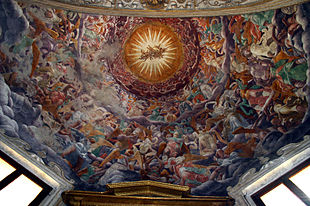
Back Arte de la segunda mitad del siglo XVI en Milán Spanish Arte del secondo Cinquecento a Milano Italian

The art of the late 16th century in Milan developed, as elsewhere, along several strands and styles summarized in Mannerism, Counter-Reformation art, and Classicism. These currents divided the city's art scene, often undergoing mutual influences.
The Milanese art scene of the late 16th century must therefore be analyzed by considering the city's particular position: while for the Spanish Empire it represented a strategic military outpost, from a religious point of view it was at the center of the conflict between the Catholic and Reformed Churches. Consequently, the greatest contribution was made by religious art in the face of less civil artistic and architectural production.[1]
Although in adopting the Mannerist style, the city's patrons and artists had examples of central-Italian derivation as a reference, the city's location near Protestant Switzerland made Milan one of the main centers of the flourishing and elaboration of Counter-Reformation art, due to the widespread action of the archbishops St. Charles Borromeo and Federico Borromeo.[2][3][4]
- ^ Denti (1988, p. 8).
- ^ La storia dell'arte (2006, p. 491).
- ^ Dezzi Bardeschi (2006, p. 34).
- ^ Mezzanotte (1968, p. XLI).
© MMXXIII Rich X Search. We shall prevail. All rights reserved. Rich X Search